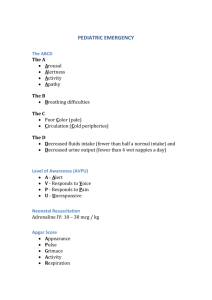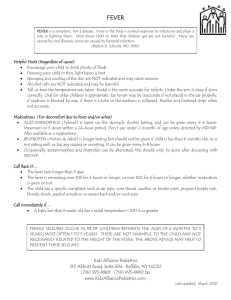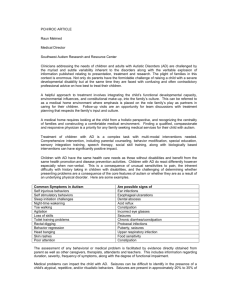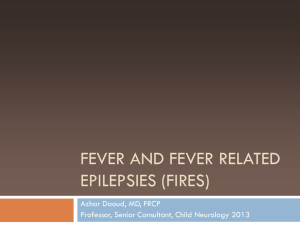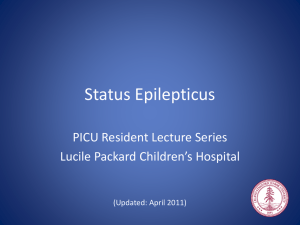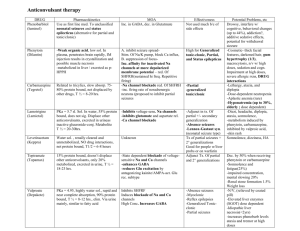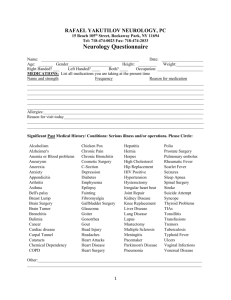Pediatric Medical Emergencies
advertisement
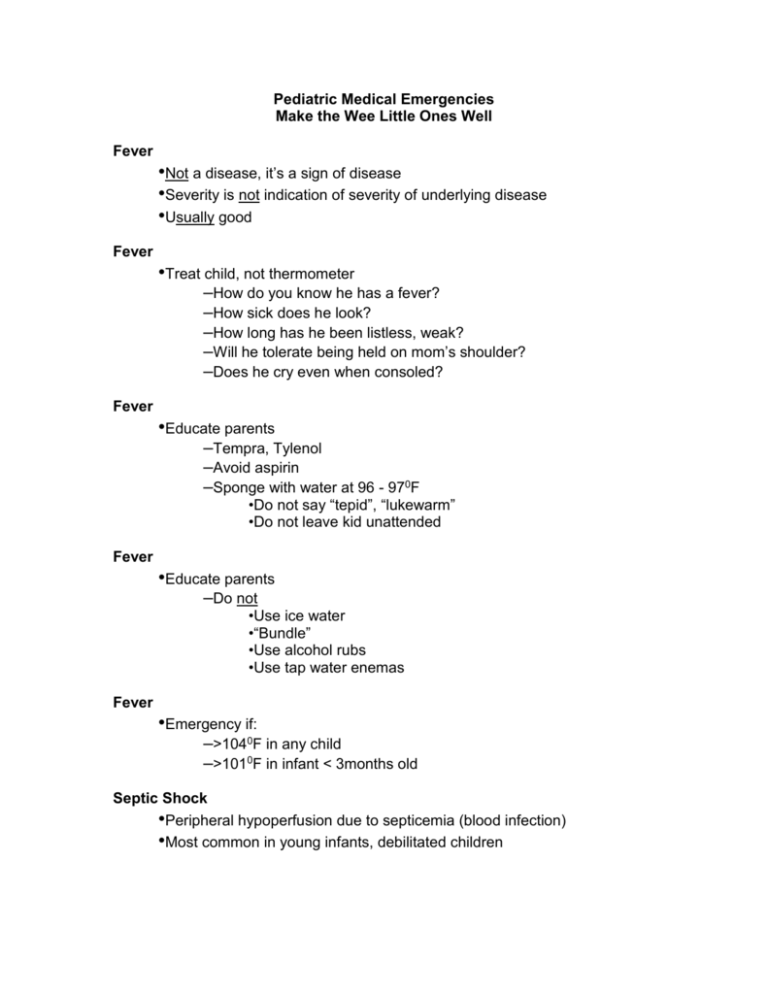
Pediatric Medical Emergencies Make the Wee Little Ones Well Fever •Not a disease, it’s a sign of disease •Severity is not indication of severity of underlying disease •Usually good Fever •Treat child, not thermometer –How do you know he has a fever? –How sick does he look? –How long has he been listless, weak? –Will he tolerate being held on mom’s shoulder? –Does he cry even when consoled? Fever •Educate parents –Tempra, Tylenol –Avoid aspirin –Sponge with water at 96 - 970F •Do not say “tepid”, “lukewarm” •Do not leave kid unattended Fever •Educate parents –Do not •Use ice water •“Bundle” •Use alcohol rubs •Use tap water enemas Fever •Emergency if: –>1040F in any child –>1010F in infant < 3months old Septic Shock •Peripheral hypoperfusion due to septicemia (blood infection) •Most common in young infants, debilitated children Septic Shock •Pathophysiology –Severe peripheral vasodilation –Fluid loss from vessels to interstitial space Septic Shock •Signs/Symptoms –“Warm” shock •Tachycardia, full pulses •Slow capillary refill •Fever •Flushed skin Septic Shock •Signs/Symptoms –“Cold” shock •Tachycardia, weak pulses •Slow capillary refill •Cool, pale, mottled skin Febrile infant + Won’t tolerate being held to shoulder = Septic Shock Septic Shock •Management –100% oxygen –LR in 20cc/kg boluses •Fill dilated vascular space •Prevent onset of “cold” shock Meningitis •Inflammation of meninges –Increased CSF production –Cerebral / meningeal edema –Increased intracranial pressure Meningitis •Signs/Symptoms: Older Children –Fever –Headache –Stiff neck (can’t touch chin to chest) –Decreased LOC –Seizures Meningitis •Signs/Symptoms: Infants –Difficulty feeding –Irritability –High-pitched cry –Bulging fontanelle –Classic meningeal signs possibly absent Meningitis •Meningococcemia –Petechial rash –Septic shock –DIC Reyes’ Syndrome •Non-communicable •Affects ages 2 -19 •Mostly toddlers, pre-schoolers Reyes’ Syndrome •Pathophysiology –Dysfunction of hepatic urea cycle enzymes –Increased protein breakdown leading to rise in blood ammonia levels –Diffuse cerebral edema Reyes’ Syndrome •History –Previously healthy child –Recovering from viral illness –Frequently chicken pox or influenza –Frequently received aspirin during illness Reyes’ Syndrome •Signs/Symptoms –Prolonged, violent vomiting –Varying degrees of personality change –Unusual behavior –Irritability, drowsiness History of vomiting + Altered LOC + Recovering from virus = Reyes’ Syndrome Crankiness in infant + Recovering from virus = Reye’s Syndrome Reyes’ Syndrome •Management –Avoid overstimulation –IV’s at TKO –Decrease ICP by controlled hyperventilation Seizures •Second most common pediatric complaint after fever •Can result from same causes as adult seizures Seizures •Pedi seizures can also result from fever –Most common from 6 months to 3 years –Caused by rapid rise in body temperature –Short-lived –Does not recur during that illness Seizures •Potential dangers –Aspiration –Trauma –Missed diagnosis Seizures “Febrile seizure” diagnosis risky in field Seizures •History –Previous seizures? –Previous febrile seizures? –Number of seizures this episode? –What did seizure look like? Seizures •History –Remote, recent head trauma? –Diabetes? –Headache, stiff neck? –Petechial rash? Seizures •History –Possible ingestion? –Medications? Seizures •Physical exam –ABC’s –Neurological exam –Signs of injury? –Signs of dehydration? –Rash, stiff neck? –Bulging, depressed anterior fontanelle? Seizures •Management--if actively seizing: –Place on floor away from furniture –Position on side –Prevent injury –Do not restrain –Do not force anything between teeth Seizures •Management--following seizure –Check ABC’s, suction prn –Assure good oxygenation, ventilation –Vascular access –Check blood glucose, if < 70, give D25W –If febrile, remove excess clothing, sponge with water to cool patient. Status Epilepticus •Diazepam: –0.3 mg/kg to 5mg if < 5 years old –0.3 mg/kg to 10mg if > 5 years old Status Epilepticus •Administer diazepam slowly •Anticipate respiratory arrest, hypotension •Rectal route is alternative when vascular access cannot be obtained Most Common Cause of Seizure Deaths = Anoxia Hypoglycemia •More common than in adults, especially in newborns •Signs/symptoms may mimic hypoxia Hypoglycemia •Check blood glucose in any child with: –Seizures –Decreased LOC –Severe dehydration –Known hypoglycemia or diabetes –Pallor, sweating, tachycardia, tremors Hypoglycemia •Management –Oral sugar if tolerated –2cc/kg D25W, if oral sugar not possible –? Glucagon 1 mg IV or IM •Reassess every 20 - 30 minutes Diabetes Mellitus •Typically insulin-dependent •Complications –Hypoglycemia –Hyperglycemia, DKA Diabetes Mellitus •DKA therapy same as for severe dehydration •Not every diabetic is known diabetic •Every diabetic must have first hyperglycemic episode Coma •Disturbance in consciousness; patient unresponsive to stimuli •Causes –Metabolic –Structural Coma •Metabolic causes: Anoxia Drug Toxicity Hypoglycemia Epilepsy DKA Reyes’ Syndrome Infections Increased ICP (Edema) Coma •Structural causes: –Trauma –Tumor –CVA Coma Control ABC’s before worrying about cause!! Coma •Airway/Breathing –All patients with decreased LOC receive oxygen!! –Evaluate for ineffective breathing patterns –Controlled hyperventilation if increased ICP suspected Coma •Circulation –Control bleeding –Give fluid boluses for hypovolemia •Disability –AVPU, pupils –Check blood glucose Coma •Management –Support ABC’s –2 cc/kg D25W glucose < 70 mg% –Narcan 0.1 mg/kg IV/IM/SQ/ET –Elevate head 300 if C-spine injury not suspected and patient not in shock –Rapid transport –Reassess, Reassess, Reassess Poisoning •Incidence –Accidental: 75% children < 5 years old –Overdose: School-age, adolescents Poisoning •Assessment –Remove to safe environment –Control airway –Support breathing: 100% O2 –Circulation - vasodilation, decreasing myocardial tone, hypoxia –Blood glucose Poisoning •History –What? –When? –How much? –Vomiting? Coughing? Seizures? Altered LOC? –Ipecac? Poisoning •Management –Support ABC’s –Consider D25W, Narcan –Ipecac?/Charcoal? –Transport samples –Consult poison control –Treat patient, not poison!! Near-Drowning •A leading cause of childhood death •Two major groups –Toddlers –Adolescents Near-Drowning •Pathophysiology –Hypoxia –Acidosis –Hypothermia –Aspiration, pulmonary edema, atelectasis Near-Drowning •Management –Protect rescuers –Assume C-spine injury –100% oxygen –Decompress stomach early with gastric tube Near-Drowning •Management –Remember mammalian diving reflex!! –Think about underlying causes •? Child abuse –All near-drownings are transported regardless of how good they look!!!
